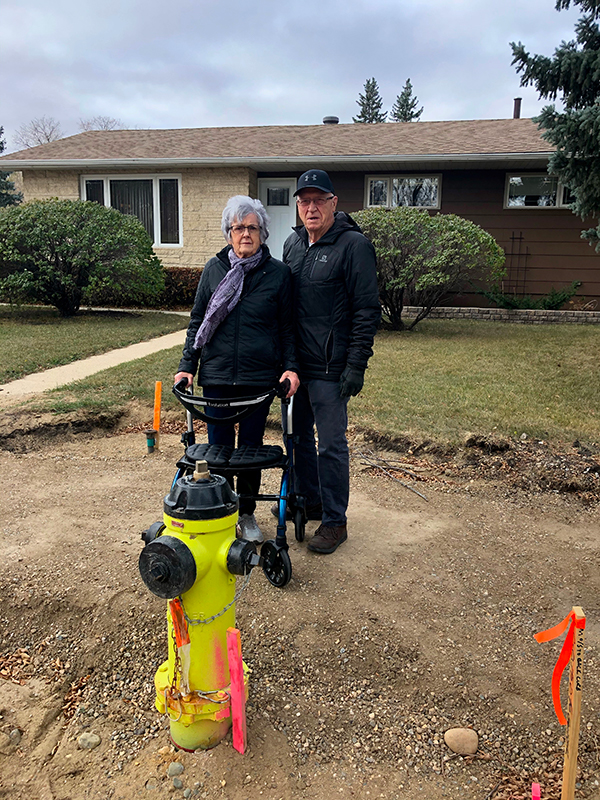“They then contacted the city planning department and were informed that their opinion was irrelevant as the city had decided the hydrant was going to be placed there and they would have to live with it.”
By Gerrie Beachall
Aging in place means having the health and social supports and services you need to live safely and independently in your home or your community for as long as you wish and are able. It has become a popular topic of discussion as the baby boomers face their retirement years. The question is how serious is our current society about achieving this option for an aging population?

Supporting our seniors to age in place is an excellent way to encourage health and wellness as they age. The ability to remain in the community eases the burden on the health care system including long term care facilities. It can also ensure that seniors remain active and engaged in their community which has multiple benefits for both the community and the senior.
Aging in place involves the commitment of all members of society and various levels of government. The individual plays a significant role in successful outcomes from having input into the policies developed by government to taking an active approach to planning how their aging in place plan can work for them. This means having a long hard look at where they would like to spend their retirement and the subsequent years following that. This will involve conversations with partners and family members about the types of activities they wish to be engaged in. Do they involve remaining independent in their home? Will they continue to drive? Can they identify how they want to spend their time and how to access these activities as their level of mobility or independence changes over time?
It starts at the municipal level
At the local level, it involves the municipal government, which is responsible for keeping the communities clean, safe and accessible for all members. At the provincial and federal level, policy and program decisions about shifting the focus away from institutional care to community care are critically important. Infrastructure funding must factor in short and long-term accessibility for community members who experience a variety of mobility and accessibility needs. Focusing on these criteria will benefit all community members, not just seniors who are aging in place.
The planning departments of local cities and towns must accept their role in supporting our seniors. The various policies and programs they create for use of space and road networks in our communities must also factor in the impact of these changes on the members of the community. After raising a family in the home you have built and dutifully paid taxes for, one would expect that changes made in the community could and should have some level of consultation. Unfortunately, there are cases where the consultation appears to involve minimal true community engagement and, in some cases, no engagement at all.
Uncaring response
My family has experienced a recent example of when decisions are made with no apparent consideration on the impact to community members. There has been a significant road renewal project underway on the street my where parents have lived for over 45 years. This project will result in improvements for the area; however, the planners did not consider the placement of a fire hydrant and subsequent removal of a street light and its impact on seniors in the area.
The placement of a fire hydrant should be an improvement to an area that everyone is pleased about. Unfortunately, in this case, they chose to place it directly in front of the only house on the street with extremely limited frontage. It happens to also be my parent’s house. The city did so without notifying them that this was being installed or where it was going to be placed.
The hydrant now blocks all access to the front street for my mobility challenged parents. The fire hydrant is on a curve in the street between two driveways on either side of my parent’s home. The neighbors have the option of parking in the driveway. My parents or anyone else who will live there in the future, will not have the option of parking in front of their home.
This lack of accessibility is a significant barrier for my mother who has limited mobility and requires a walker to navigate her way to the front door. As good, reliable community members and taxpayers, they reached out to their local city councillor. They did not receive a response.
They then contacted the city planning department and were informed that their opinion was irrelevant as the city had decided the hydrant was going to be placed there and they would have to live with it. To add insult to injury, the planner indicated that moving it to the property line would involve removal of a tree and that was not acceptable to the city. The message to my parents is that a tree is more important than my parent’s ability to remain independent and successfully age in place.
The removal of a streetlight is another example of thoughtless planning about how this lack of lighting would impact a senior’s ability to navigate the community, especially in a climate where the hours of sunlight reduce drastically for many months. The lack of adequate lighting is also a public safety issue for others on the street.
If this is how our cities choose to treat our seniors and others who require accommodations to be mobile and remain Independent in their community while they age in place, then the goal of aging in place seems like more of a pipe dream.

